Asylum Hill graves relinquish stories, surprises to field school students
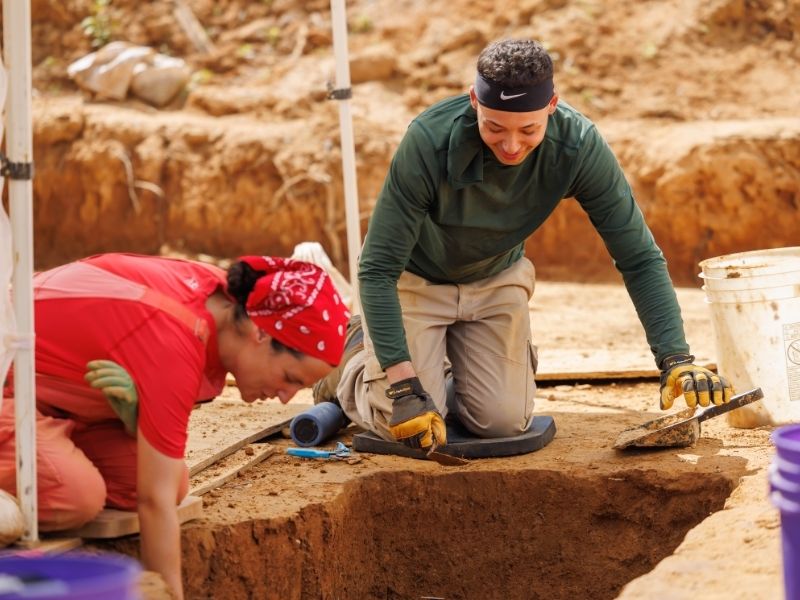
Video By: Win Graham/ UMMC Communications
On a slope of land managed long ago by a mental hospital, a group of students is digging holes in order to fill in the blanks.
These biographers are writing with trowels and shovels, brushes and buckets, as they try to exhume the stories of some of the thousands of people buried in now unmarked graves on the University of Mississippi Medical Center campus.
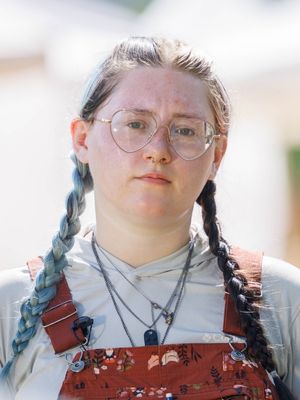
“You’re really reconstructing an individual’s life; there’s a lot of beauty in that,” said Savannah Logan, her overalls smeared with soil the color of the flaming summer sun.
“These were people here; they are people,” said Logan, who has a master’s degree in anthropology, “and they have descendants who care about them and want to know about them – I’m a little bit of a romantic here.”
The romance of an archaeological dig is part of the attraction for Logan and about 19 other graduates and undergraduates in this year’s Asylum Hill Project Field School at UMMC.
The project’s third-ever field school opened June 30 and will continue to the first week of August as students unearth the remains of patients who died at the Mississippi State Lunatic Asylum, also known as the State Hospital for the Insane.
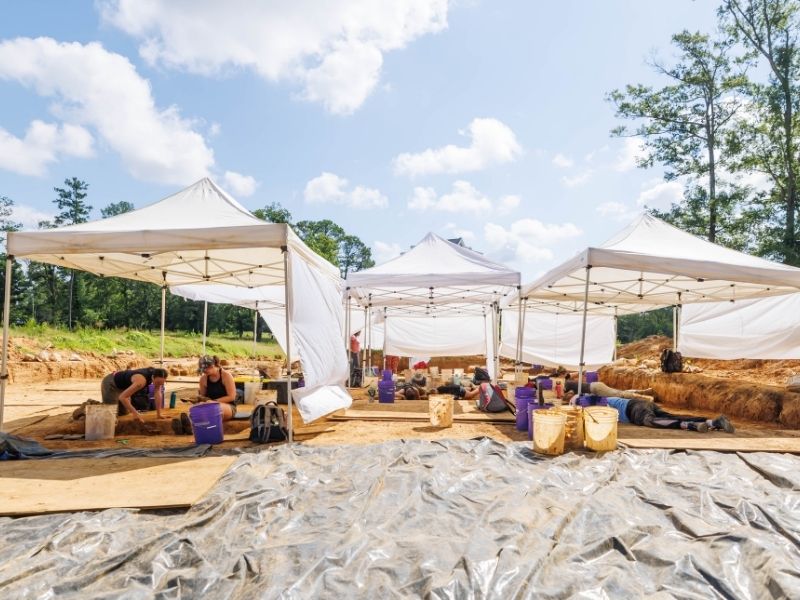
Directed by Dr. Jennifer Mack, lead bioarchaeologist and an assistant professor in the John D. Bower School of Population Health at UMMC, it’s part of the mission to excavate, study and respectfully memorialize patients from an institution that operated from 1855 to 1935 on what became Medical Center land.
In the northeast corner of the campus, alongside University Drive, the students are working with Mack and her professional archaeological crew: Gabby Lofland, Emily Wicke, Stacia Yoakam, Bryce Sermons, Katherine Dunning and Melanie Hasey.

“Our goal is to train the next generation of bio-archaeologists, not just in proper techniques, but also in ethical excavation and in ways to conduct this kind of research with respect for the dead and their descendants,” Mack said.
Through the project, UMMC is documenting personal items discovered in the graves and placing them and the human remains in a lab near the UMMC Cemetery. Everything is cleaned and stored there for analysis.
Afterward, UMMC officials will reclaim burial land for potential development. A memorial to the patients is planned, as is the creation of a permanent resting place for those who could not be positively identified and returned to their families for reburial.
“Descendants are welcome to visit the excavation site,” said Mack, who keeps them updated with a monthly newsletter.
The excavations are taking place under white shelter tents that have popped up like giant, gauzy mushrooms on the most southward point of the cemetery area worked so far, Mack said.
“We should be going back in time farther that we’ve gone before.”
This is what Logan, for one, signed up for – twice. A veteran of last summer’s field school, the Hattiesburg resident representing the University of Southern Mississippi returned as one of two teaching assistants.
“The individuals buried here are pretty reflective of Mississippi as a whole for that time,” said Logan, a North Carolina native. “They came from all over the state. Some spent nearly their entire lifetimes here.”
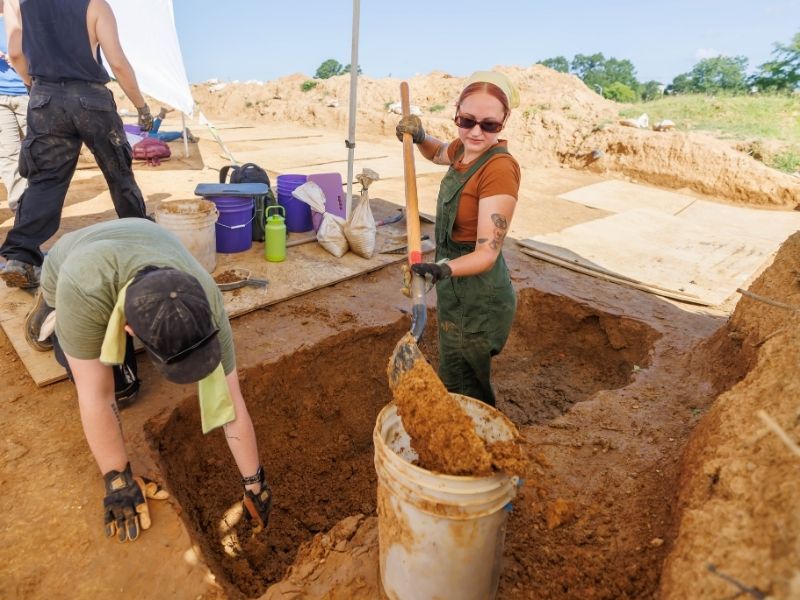
Of the estimated 4,000-7,000 interments, 778 individuals associated with the asylum have been removed. Those include the 66 uncovered more than a decade ago after a road construction crew found a single pine coffin. In November 2022, Mack and her professional crew began revealing more. The following summer, the first field school opened.
“A field school is required by most archaeology and anthropology degrees,” Mack said. “Also, it’s pretty essential for getting into graduate school programs or getting jobs in cultural resource management.”
The students, who are housed at Millsaps College, have come from as far away as Washington state and Brown University in Rhode Island this year. Three represent Mississippi institutions. The students earn eight hours of semester credit through the Center for Field Sciences (CFS).
“Our field school is unique because we allow students to work on human remains,” Mack said. “It’s a very rare opportunity in the United States, where human burials are a very sensitive subject.
“Normally, students have to take part in field school in another country to get the same experience.”
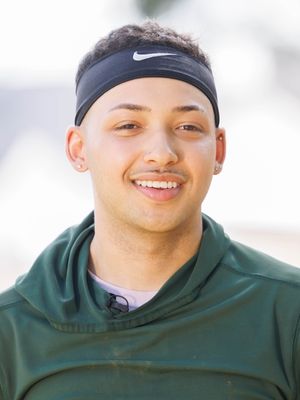
Bryan Hill, a West Virginia native and this year’s “happy and blessed” field school scholarship recipient, has been on an excavation in Peru. “But we didn’t deal much with human remains; it was mostly artifacts,” said Hill, an anthropology graduate student from the University of West Florida in Pensacola.
“I’m the first person in my family to go to college, so, I’m sure my parents were expecting me to become a doctor or lawyer, but ever since I was a kid I was interested in archaeology. I was really big into video games then, like Tomb Raider – although we’re more ethical than that.”
Hill is working on a grave containing an uncommon find here: a stacked burial – where coffins are placed on top of each other.
“I hope we’ll find something that relates each person to one another – a family member or something,” Hill said. “I would like to think that’s the reason they’re stacked and not because they ran out of space.”
Although bone preservation is poor at this site, Mack said, the graves have yielded some scarce and captivating artifacts. Some of the latest discoveries include a vulcanized rubber hair comb, a coffin featuring a lid with a glass viewing pane, and remnants of a shoe.
That shoe is only the third such find, Mack said. “Even today, most people aren’t buried in shoes.” Such revelations offer clues to the personalities and circumstances of the people laid to rest with them – or to those who buried them.
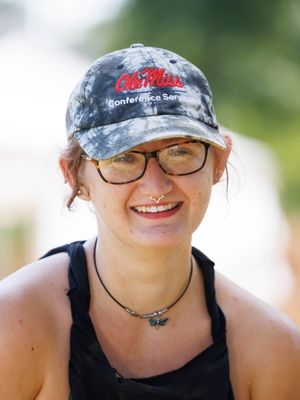
This field school experience is “opening our eyes” to life and the state of health care in Mississippi during the late 19th and early 20th century, said Maggie Wallace of Mendenhall, a University of Mississippi undergraduate planning to pursue mortuary archaeology and bioarchaeology.
“An added bonus is that it is so close to my hometown; also, it is very much connected to Mississippi history, local history, social history.
“The passion of the instructors and professionals here is incredible, especially for a project of this magnitude. It has provided a fantastic opportunity to learn from others in similar fields.”
Scraping away dirt day after day under a ruthless Mississippi sun is a passion not everyone may understand. “When I told my family what I would be doing, the heat wasn’t much of a concern for them because I’ve been out in it my entire life,” Wallace said.
“They weren’t put off by the idea, but they were like: ‘You have fun; you do what you love, and I’m happy for you.’”
For his part, Hill has enjoyed finding out the stories of the living as well: “The people I work with, we’re like a family,” he said. “I certainly feel like it’s going to be an experience where I walk away with lifelong friendships.”


